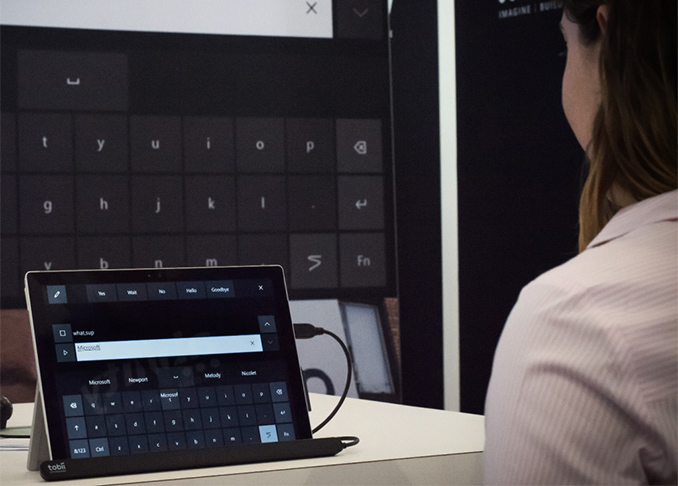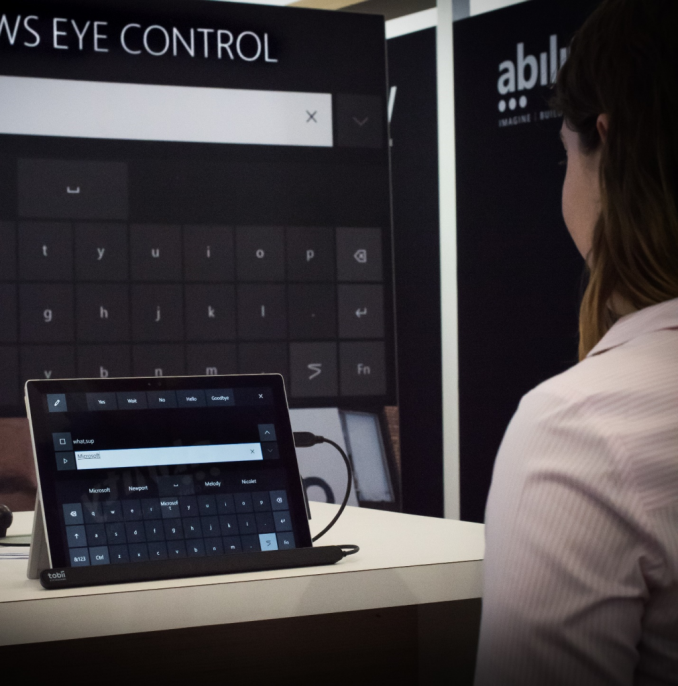Microsoft to Enable Eye Control in Windows 10
by Anton Shilov on August 7, 2017 1:00 PM EST- Posted in
- Operating Systems
- Microsoft
- Windows 10
- Tobii
- Eye Control

Microsoft CEO Satya Nadella this past week announced plans to add support for eye tracking to one of the upcoming Windows 10 versions, in a bid to enable disabled people to use computers. The head of Microsoft did not say when the company intended to do this, but only said that the tech would require a compatible eye tracker, such as the Tobii 4C, which is currently supported by some games and may be used to control a Windows-based PC when appropriate software is installed.
According to an MSDN blog post, the Eye Control feature has been in development for quite some time — the initial idea to integrate something like that was proposed in 2014. At present, the capability is in beta and interested people can participate in early testing and provide feedback using the Windows Insider program. Microsoft positions the Eye Control primarily as a way to make PCs more accessible to people with disabilities, such as ALS.
Microsoft does not disclose many technical details about its Eye Control feature, but only says that the Tobii Eye Tracker 4C will be one of the compatible eye-tracking devices. Meanwhile, the Tobii 4C is a rather sophisticated piece of hardware that can be purchased separately (€159 in Europe).
Correction 8/8: The Tobii 4C sensor is integrated into laptops and displays by Acer and Alienware. By contrast, the previous-gen EyeX is only found in select notebooks by MSI and is sold by SteelSeries as the Sentry standalone unit.
The Tobii 4C is equipped with near-IR 850 nm diodes and an RGB camera to track eye positions, gaze points and head position. With the 4C, Tobii not only switched IR sensors in a bid to get rid of red lights, but also increased polling rate of the device to 90 Hz (up from 60 - 75 Hz on the previous-gen EyeX), which theoretically reduces eye to application latency from 15±5 ms on the previous gen model. The latter factor is important for comfortable interaction with applications and if we are talking about a prolonged usage of a PC by a disabled person, comfort (actually, more like lack of eye fatigue) becomes crucial. Back to hardware. Another important feature of the Tobii 4C is its specially designed EyeChip ASIC (also used in the EyeX) that reduces CPU load and has a built-in “eye-tracking algorithm”. Tobii admits that eye tracking may take up to 10% of a high-end CPU time (1% with the EyeChip), so it is not really a demanding task. However, if hardware processing also reduces input latency, this may be an important factor. After all, Microsoft chose the Tobii platform to develop its Eye Control feature for a reason. The software giant needed a polished-off solution (already compatible with numerous games) that enables certain level of interaction with Windows out-of-the-box. Another advantage of the Tobii could be its hardware-based processing and a relatively low input latency (still 15 ms on the EyeX does not seem very low).
Without actual data at hand, it is unclear what Microsoft’s Eye Control feature is going to require. Microsoft wants to make Windows 10 accessible to everyone, so it is highly unlikely that an expensive eye-tracking device will be mandatory. Nonetheless, it is obvious that a typical webcam will not be enough for this feature.
Related Reading:
Source: MSDN












32 Comments
View All Comments
Flunk - Monday, August 7, 2017 - link
It's always nice to give disabled people another option. I'm sure this will make a very small number of people extremely happy.HardwareDufus - Monday, August 7, 2017 - link
To bad Windows 10 Mobile development has stopped. If I had this feature on my Lumia 950XL, I could blink at my phone to activate the Snooze Button when my alarm goes off.Diji1 - Monday, August 7, 2017 - link
Maybe a little too easy :pComdrpopnfresh - Sunday, August 13, 2017 - link
You would probably want it set so you have to blink a pattern. Otherwise, you'd never wake on time.Bullwinkle J Moose - Monday, August 7, 2017 - link
Well I for one think its great that Microsoft Insiders got to design Windows 10 and list all the features they wanted Microsoft to implement in this new O.S.O.S. support for Facial tracking, fingerprint reading, voice analysis, keylogging everything you type, monitoring Skype communications and backdooring Bitlocker encryption is very important to the modern security consious comsumer these days
As insiders, we asked for DRM at every turn and demanded that Microsoft not be held liable for accessing anything they want on "our" computers
We demanded that Microsoft be allowed to profit directly from our loss
We asked for advertising everywhere
Screw National Security!
We want backdoors on EVERYTHING!
(This Advertisement was Sponsored by The Fake News Network)
Alexvrb - Monday, August 7, 2017 - link
Yes, comsumers are really getting screqed over. Even though it works fairly well for like a half billion people. Even though you can turn this stuff off, even though they don't actually run a keylogger in the true sense, even though you're full of it and trolling as usual. Even though Google is a far bigger offender and even pays for offline purchase information (they have their paws in 70% of credit card transactions). But yeah, MS is always the boogeyman with you.at80eighty - Monday, August 7, 2017 - link
excellent post. your check is in the mail as promised.SpartanJet - Tuesday, August 8, 2017 - link
I'd bet anything you have a phone using that spyware OS ADroid and give gogle all the data they could possibly mine out of you with there """free""" spyware/tracking software without a second thought. Gogle must pay its shills well to spew this BS.chrome_slinky - Monday, August 7, 2017 - link
Steven Hawking may be happy, others, not so much.Wondering how much could be better for everyone, if Microsoft got over their paternalistic views of development, and actually asked [then implemented] changes the user base wanted.
B3an - Monday, August 7, 2017 - link
kys.